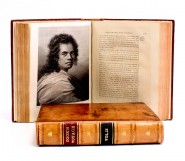Lot #40 - Colin McCahon
-
Auction House:Webb's
-
Sale Name:Important Paintings and Contemporary Art
-
Sale Date:06 Dec 2011 ~ 6.30pm (NZ Time)
-
Lot #:40
-
Lot Description:Colin McCahon
Colin McCahon – Comet (F11) Comet (F11) belongs to suite of works that McCahon produced in 1974 while working from his studio in Muriwai (w
acrylic on unstretched jute canvas
920mm x 620mm
signed C.McC., dated '74 and inscribed Comet (F11) in brushpoint lower edge -
Provenance:Green, Tony. Colin McCahon's 'Necessary Protection' In Auckland. Art New Zealand Magazine, No.134, winter 2010.
-
Exhibited:Jumps and Comets: Related Events In My World - Colin McCahon, Barry Lett Galleries, 27 May - 7 June 1974.
-
References:Colin McCahon Database Reference (www.mccahon.co.nz) cm001562
-
Notes:Colin McCahon - Comet (F11) Comet (F11) belongs to suite of works that McCahon produced in 1974 while working from his studio in Muriwai (where he was based from 1968 to 1978); it has been suggested that every work that he painted during this year (including the Blind and Jump series) was cut from a single role of jute sacking, identified by a purple thread that marks the selvedge. Each work from the Comet series shares a similar format: an evenly daubed black background overlaid with an arrangement of sparsely distributed horizontal strokes. While every work carries an individual code based on the classification system used for naming comets prior to 1994, these works are not observations of orbital periods but, rather, they are reflections upon the fragility of human life in a universe of untamed forces. During his time at the Muriwai studio, McCahon made many works that reflected upon the division between earth and sky, with the compositional structure often relying on only a solitary horizontal line. While these works were deeply grounded, McCahon has here presented us with a physical impossibility: a comet - described by a burst of white and a tail that gently kisses the pronounced jute weave - sandwiched between two parallel horizons. A clarification of the artist's rationale can be found in the Blind series that directly preceded the Comets. These works, too, consisted of a double horizon; however, while the lower band parted earth and sky, the upper boundary separated the sky from the heavens. As such, the amber line offers itself as divine presence, a world away from the chaos far below. The black, uninterrupted stillness of this work has a moving calm. Without a single light in sight, it is easy to imagine the artist at his studio, staring out over the water and into the night sky, pondering the unseen events occurring in the darkness of space. This work was painted only a few years before McCahon was forced to move from his studio in Muriwai and work once again from his family home in Grey Lynn. His rapidly deteriorating health, caused by decades of alcoholism, denied him the ability to make the long drive out to the west coast. Therefore, it is hard to say whether this is the work of a believer or of a man who had lost faith. The comet, sailing over the surface of the work, presents as both an omen of apocalypse and as evidence of a divine influence on the forces of the universe. It calls into question the incidental nature of life, which can flourish if given only a little nourishment and yet can just as easily be crushed without warning, in the blink of an eye. The Comets act as a bookend to the works made in the latter part of McCahon's Muriwai tenure. They demonstrate a distinct shift from his earlier engagement with earthly physics to a fascination with objects that weren't governed by the forces of gravity. In formal terms too, the artist's refined use of a binary colour scheme can be seen to pave the way for the Noughts and Crosses and Rocks in the Sky works that he would produce in 1976, where free-floating objects were suspended in black space. CHARLES NINOW
-
Estimate:NZ$160,000 - 220,000
-
Realised Price:
-
Category:Art
This Sale has been held and this item is no longer available. Details are provided for information purposes only.










